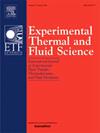SAMPO-P:关于低浓铀浓缩反应堆下封头两层熔池传热的原型规模低温实验
IF 2.8
2区 工程技术
Q2 ENGINEERING, MECHANICAL
Experimental Thermal and Fluid Science
Pub Date : 2024-09-12
DOI:10.1016/j.expthermflusci.2024.111303
引用次数: 0
摘要
为了更好地了解高雷利数双层熔池的热行为--RASPLAV 研究中观察到的模式表明压力容器的完整性和舱内滞留(IVR)策略的成功面临重大风险--本文报告了二维全尺寸(1:1 比例)原型分层熔池(SAMPO-P)的实验结果。在不同的加热功率和顶层高度下进行了一系列实验测试,雷利数达到 3.77×1015,与轻水反应堆(LWR)中的雷利数相当。水被用来模拟底层,而正辛醇则代表顶层。在底层使用电热棒模拟内部衰变热。在分析了实验中的主要传热参数后,本文得出了几种有用的传热相关性。不同功率水平下的归一化温度和热通量分布保持一致,底层的归一化热通量与现有的实验相关性非常吻合。与其他单层相关性相比,底层的向下传热系数较低,这可能是由于向上传热增加所致。本文章由计算机程序翻译,如有差异,请以英文原文为准。
SAMPO-P: A prototypical scale low-temperature experiment on two-layer melt pool heat transfer in LWR lower head
To better understand the thermal behavior of a two-layer melt pool with a high Rayleigh number—a pattern observed in the RASPLAV study, which indicates a significant risk to pressure vessel integrity and the success of in-vessel retention (IVR) strategies—this paper reports experimental findings from a 2D, full-scale (1:1 ratio) prototypical stratified melt pool (SAMPO-P). A series of experimental tests were carried out with varying heating powers and top layer heights, achieving a Rayleigh number of , comparable to that found in light water reactors (LWR). Water was used to simulate the bottom layer, while n-octanol represented the top layer. Internal decay heat was modeled in the bottom layer using electric heating rods. After analyzing the main heat transfer parameters from the experiment, this paper derived several useful heat transfer correlations. The normalized temperature and heat flux distributions remained consistent across different power levels, and the normalized heat flux in the bottom layer aligned well with existing experimental correlations. In the bottom layer, the downward heat transfer coefficient was lower compared to other single-layer correlations, likely due to increased upward heat transfer.
求助全文
通过发布文献求助,成功后即可免费获取论文全文。
去求助
来源期刊

Experimental Thermal and Fluid Science
工程技术-工程:机械
CiteScore
6.70
自引率
3.10%
发文量
159
审稿时长
34 days
期刊介绍:
Experimental Thermal and Fluid Science provides a forum for research emphasizing experimental work that enhances fundamental understanding of heat transfer, thermodynamics, and fluid mechanics. In addition to the principal areas of research, the journal covers research results in related fields, including combined heat and mass transfer, flows with phase transition, micro- and nano-scale systems, multiphase flow, combustion, radiative transfer, porous media, cryogenics, turbulence, and novel experimental techniques.
 求助内容:
求助内容: 应助结果提醒方式:
应助结果提醒方式:


